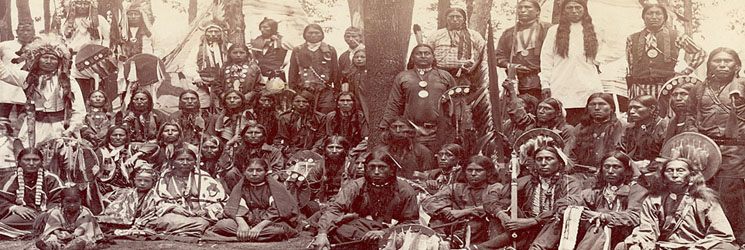In the days before white Europeans came to North America, the Cheyenne, “people of strange speech,” lived in the fertile prairie and wooded hills along the banks of the Missouri and Red rivers. The area was lush with wild berries and wild game, including buffalo that came to feed on the great grasses of the area.
During the winter months, the Cheyenne set up camp in sheltered areas near water sources. The rest of the year, however, they were nomadic, following the buffalo herds. When a herd was located, camp would be set in the traditional circle and plans for the hunt got underway. Buffalo were critical to the Cheyenne, not only as a food, but as a source for clothes, tipi covers and tools.
Like most Plains Indian tribes, Cheyenne men wore buckskin breechcloths, buckskin shirts and moccasins. The women wore one-piece dresses adorned with beadwork or decoration made from porcupine quills. Fringe was often seen on Plains clothing, not only for decorative purposes, but practical as well. The movement of the fringe served as a continual “fly swatter” against the many insects of the prairie. Fringe also provided a ready source of a lashing tool should something need to be bound. In winter, leggings and buffalo robes were added for warmth.
Heammawehio, the creator of all things, was at the center of the Cheyenne belief system. Another deity was Sweet Medicine, who bestowed the Cheyenne with four arrows – two with power over men and two with power over the buffalo.
The Cheyenne have a more varied history than many North American tribes. Before migrating west to the Plains, the Cheyenne were a Midwestern woodlands tribe. They lived not in tipis at that time, but in the bark wigwams typical of the woodlands people. and ate a diet based in wild rice rather than buffalo. They next moved south, became farmers and adapted a lifestyle centered the earth lodges of agricultural peoples. By the 1700s they had found a home on the Great Plains, living in tipis and hunting buffalo.
When the Gold Rush brought a host of miners, white settlers and soldiers to their territory, the Cheyenne resisted. The army was set upon them in war over the land, and even once chief Black Kettle surrendered under a flag of truce at Sand Creek, soldiers deathly afraid of Indian hostility massacred the more than 200 Cheyenne. This brutal act rallied other Cheyenne and their allies, the Arapaho. Retaliatory raids against white settlements erupted immediately, beginning a decade of fighting between Indians and whites known as the Sioux Wars.
The Northern Cheyenne were eventually settled on a reservation in the west in what was known as “Indian Territory.” This place was crowded and barren, with soil too poor to farm and hunting land that was all played out. Having waited patiently for government supplies that never arrived, Cheyenne leader Dull Knife and his band chose to leave the reservation to hunt. Army troops tracked them down and killed everyone but a few who escaped into the mountains.
Eventually, there were approximately a mere 80 Cheyenne left. These survivors were moved to a reservation in southeastern Montana, where many still live today. Other members of the Cheyenne live in Oklahoma.





